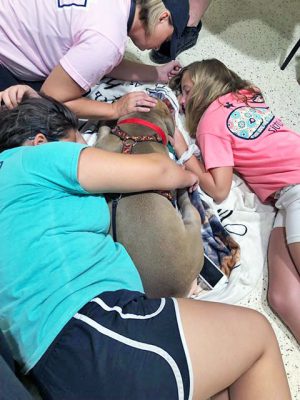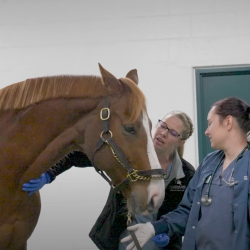History and Presentation

Marlo, a three-year-old Pit Bull, presented to Michigan State University’s Emergency and Critical Care Medicine Service (ECCM) as a referral for evaluation of a one-week history of stranguria/dysuria and recent diagnosis of urethral obstruction. Marlo had no prior history of health issues or concerns.
Marlo was reported as having signs of urinary strain, with significantly decreased urine production for approximately one week. This progressed to no urine production for two days. Prior to coming to the Hospital, Marlo was seen by his primary care veterinarian. He was prescribed an NSAID (Rimadyl) and an antibiotic for a possible urinary tract infection. The next day, he presented to an emergency clinic in Ann Arbor, where he was diagnosed with a urethral obstruction. Unfortunately, a urinary catheter was unable to be passed; a decompressive cystocentesis was performed to relieve most of the urine from the bladder. Abdominal radiographs were performed, which did not reveal any evidence of urinary stones. Marlo was then referred to the MSU ECCM for further evaluation and care.

Diagnosis
On presentation and physical examination, Marlo was alert and responsive. His mucous membranes were pale pink and tacky with a CRT of less than two seconds. Cardiopulmonary auscultation was unremarkable with no murmurs, crackles, or wheezes. Abdominal palpation was markedly painful with a large, firm, distended urinary bladder. The remainder of the physical exam was unremarkable.
PCV/TS (abdominal fluid) was performed. It revealed 10 percent/2.5 g/dL. A matching PCV/TS of the venous blood was performed which revealed 61 percent/8.5 g/dL. An AFAST ultrasound was performed which revealed marked free fluid present within the abdominal cavity. Lastly, a contrast cystourethrogram exposed an irregular, ill-defined filling defect within ventral aspect of the urinary bladder. The remainder of the urinary tract was then examined. The prostatic, membranous, and the proximal and mid-penile urethra were within normal limits. At the level of the caudal aspect of the os penis, there was ventral deviation of the urethra caused by an expansile, primarily lytic lesion within the caudal aspect of the os. As the urinary catheter was retracted, there was evidence of focal narrowing of the urethra at this location. The remainder of the urethra was normal.

Fine needle aspirates also were performed. The six smears consisted of blood with many artificial hemoglobin crystals and lysed erythrocytes. There were few detectable pyknotic cells, possible neutrophils, but no other abnormalities were noted. The interpretation was concluded as a low cellularity sample consisting of mostly blood with few pyknotic cells; the nature of the lesion was not clear.
The conclusions of the study were determined as 1. Aggressive osteolytic lesion centered on the caudal aspect of the os penis, which resulted in focal narrowing of the penile urethra, and thus likely causing the partial urethra obstruction. 2. Focal apical urinary bladder irregularity. The filling defects suggested regional hemorrhage or hematoma. Chronic cystitis was considered, as was neoplasia, but it was less likely. 3. Mild peritoneal effusion suggestive of urinary bladder leakage; distinct leakage of positive contrast media was not visualized.
These findings, along with matching peritoneal and peripheral blood gases, were suggestive of uroabdomen. The ECCM team was able to decompress the bladder by placing a urinary catheter, as well as a catheter along the abdominal wall to evacuate urine from the abdomen. Once Marlo stabilized, the Soft Tissue Surgery service was consulted, and urethrostomy with penile amputation as well as scrotal ablation was determined to be the best treatment for Marlo.

Treatment and Outcome
Five days after Marlo’s arrival at the Hospital, he was transferred from the ECCM to the Soft Tissue Surgery Service for scrotal urethrostomy with penile amputation and scrotal ablation. Urethrostomy by definition means to create an opening in the urethra. The procedure is usually performed to provide a new opening in the urethra after an obstructive event, such as a blockage by a urinary stone. In Marlo’s case, the urethrostomy was performed to alleviate a urethral obstruction that was created by the mass on his os penis. In dogs, the urethrostomy is most commonly made at the level of the scrotum. As a result, Marlo was neutered during the procedure to allow for the creation of a new urethral opening.
During the procedure, the excised tissue (penis and os penis) was submitted to the Michigan State University Veterinary Diagnostic Laboratory for histopathologic evaluation. At the time of Marlo’s discharge, his prognosis was dependent on the histopathology results. One week later, histopathology results were received. The results were indicative of bone necrosis marked with hemorrhage, for which the cause could not be histologically determined. The lesion may have represented a secondary change from trauma. There was no evidence of neoplastic, inflammatory, or infectious disease process in the sections examined. The alterations did not extend to the margin sections. Therefore, complete excision appeared to have been achieved. The case was reviewed by MSU’s bone pathologist.
During his recheck appointment two weeks later, Marlo’s owner reported that he was doing very well. Marlo was able to urinate on his own, with only a small amount of blood discoloration present in his urine. His owner noted no additional concerns. His incision site had almost healed completely, with no signs of infection or irritation. Marlo’s prognosis was stated as excellent.

Comments
In Marlo’s case, the imaging findings suggested that the caudal os penis mass was the cause of the partial urethral obstruction. An aggressive lesion was considered most likely, and osteosarcoma was the probable differential. The irregular margins of the urinary bladder with suspected filling defects were likely related to chronic inflammation or hemorrhage associated with chronic pressure and leakage. Leakage of the urinary bladder was suspected based on the reduction in peritoneal detail and the irregular bladder margins. However, specific sites of urinary bladder leakage were not identified on the study. The urethra was unlikely to be the source of the leakage.
During Marlo’s urethrostomy, tissue was collected and submitted to the MSU Veterinary Diagnostic Laboratory for histopathology. The findings were consistent with bone necrosis, a benign process with no evidence of cancerous cells. Even though the cause of Marlo’s necrosis remains unknown, surgical excision of the lesion is considered curative. Throughout Marlo’s pre-operative diagnosis and until the biopsy results were obtained, the owners were prepared for the mass to be an aggressive tumor based on radiographic findings. Marlo was then given a poor-to-guarded prognosis based on our experience and previous published report of a similar case. Not only did this case have a positive outcome (the mass was benign, and surgery was considered curative), but this showed us the importance of submitting excised tissue for biopsy or histopathology evaluation. Without a definitive diagnosis, it would have been difficult to discuss the next steps in Marlo’s management, let alone inform the owner that Marlo was cured and could continue to live his life to its fullest.



